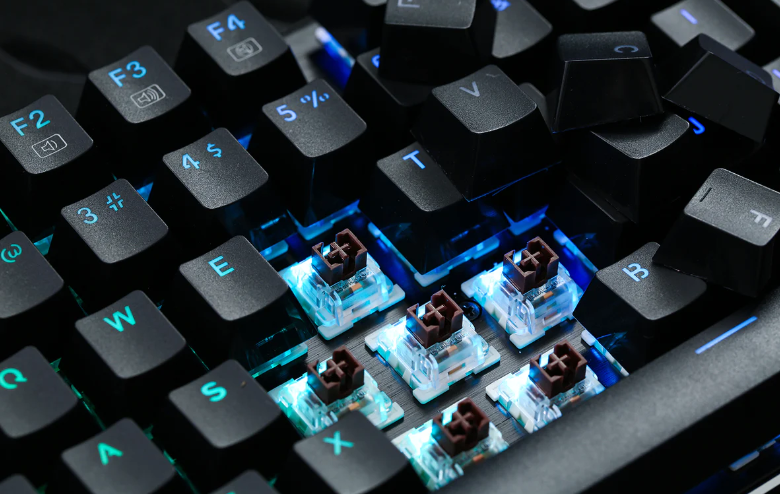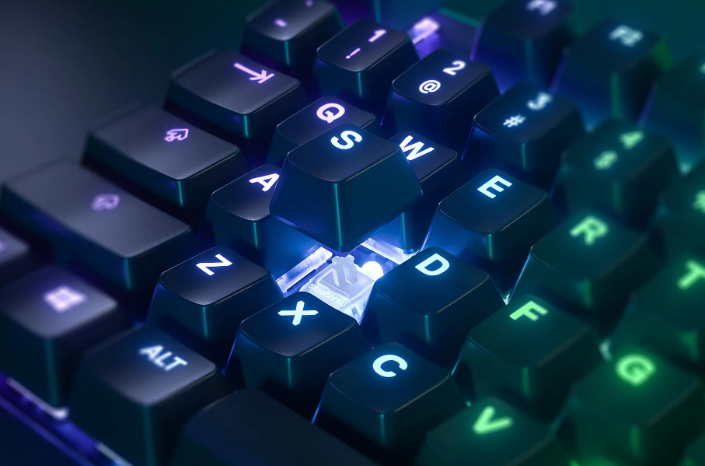Are blue switches good for gaming? (Choosing the Right Switches for Gaming) 2024

Finding a gaming keyboard that suits your needs can be difficult, especially as the market is becoming increasingly saturated. First, you have to choose between mechanical and membrane keyboards, and then which switch best suits your preferences.
On the other hand, some gamers are not even aware of the distinction between the switches on mechanical and electronic keyboards. You may know that the blue and red switches are the most popular, but are unaware of the subtle differences between the two. The goal of this article is to simplify things so you can make an informed decision.
Blue switches are bad for gaming. They make a lot of noise, and the tactile bump they’re known for makes pressing buttons feel confusing and slow you down. Also, their actuation is much worse than linear switches, while the red ones have better actuation and produce much less noise. Choose red if you want to get the best results.
However, not all gamers use their keyboards exclusively for gaming, so understanding the differences between blue and red switches can help you avoid buying a keyboard that doesn’t meet your needs.
Let’s see are blue switches good for gaming? and why red ones are.
Difference between blue and red switches
There are two significant differences between blue and red switches, both of which make blue switches less suitable for gaming. Knowing the differences will help you avoid buying the wrong keyboard for your needs.
While the red switches are categorically superior to the blue ones in terms of gameplay, there are better linear switches than the red ones. Also, some people aren’t into reaction games and therefore don’t need the actuation that linear switches provide.
Clicky vs Linear
The first and most obvious distinction between the blue and red switches is the way they are activated. The blue switches activate with a click, while the red ones click linearly. But what exactly does this imply?
When a click-type switch is pressed, a tactile bump is felt and heard, hence its name. You can hear a loud click and feel the button go over that bump when you press it. This is a response from the switch indicating that the press has been registered, but it causes problems when gaming.
Click switches require much more pressure to register a press than linear switches, the most popular of which are the red ones. As a result, the drive is quieter and much more sensitive to keystrokes, which increases precision in games.
Also, assuming you’re not banging on the keyboard while gaming, the linear switches last longer than the blue ones. They take less load over time because they require less pressure than blue switches.
Versatility
The versatility that each type of keyboard brings is the second big difference between blue and red switches. The red switches are great for both typing and gaming, while the blue ones aren’t great for either.
On the other hand, it can take some getting used to typing on red switches, because most people are used to typing on keyboards with blue switches. However, once you’ve gotten used to it, the lighter actuation of the reed switch can save you time by reducing the time between presses.
Blue switches can still be used in primarily mouse-based games like Call of Duty, as the gameplay is focused on how fast you can shoot rather than the nuance of movement.
Lastly, red switch keyboards are much more versatile and better to play with than blue switches, but they tend to be a bit more expensive.
Why Blue Switches Are Bad For Gaming

Understanding the differences between blue and red switches is a good starting point, but I want to stress that blue switches are not suitable for gaming. There are several reasons for this, which I will explain in more detail later in this section.
Noise
The noise blue switches make is the most obvious reason they’re bad for gaming. To register key presses, clicky switches use a tactile bump that makes a loud clicking noise each time a key is pressed.
On its own, that doesn’t sound like much of a problem, especially if the clicks irritate your brain in the right way. Think about how hard it will be to hear your teammates over the sounds of your keyboard, or how hard it will be for them to hear you with all the background noise coming from their side.
When you use the keyboard for regular typing, the noise can also be distracting. The sounds are loud and the sound of your writing can easily distract you. Red switches, or linear switches in general, are much quieter and eliminate this problem.
Actuation
To register key presses, clicky switches require much more pressure than linear ones. Red switches, on average, require 45g of force to register, while blue switches require 60g.
Although 15g may seem insignificant, it makes a difference when pressing a button or trying to refine movements in the game. Trying to press too many buttons in a short period on a blue switch keyboard can be confusing and slow down your input speed.
Linear switches, by contrast, are extremely touch-sensitive, making button pressing and nuance a breeze. The faster you act, the smoother your movements in the game will be, and your performance will improve.
Blue switches are fine for games that don’t require a lot of keystrokes, but when your success depends on your ability to move and enter commands quickly, a blue switch keyboard will disappoint.
Competitive Gaming
For competitive gamers, blue switch keyboards are the worst than Topre Realforce R2. Casual gamers can, albeit reluctantly, get by with a blue switch keyboard. A red or linear switch would be ideal for competitive gaming.
As competitive gaming is a high-level game class, reaction time is crucial. A blue switch keyboard requires too much force and time to react quickly to changing environments and encounters.
Let’s say you’re playing Fortnite, where you’re required to build walls and press keys quickly for most of the game. A blue switch keyboard won’t respond quickly enough to your commands in high-stress situations, putting you at a huge disadvantage.
Blue switch keyboards, on the other hand, will suffice in games like Call of Duty, where success is largely determined by who can shoot the fastest. While red switch keyboards are still the best, a blue switch keyboard will get you through a game.
Are the blue switches unusable for the game?

Although the blue switches are not as good for gameplay as the linear ones, they can still be used. You’ll have a harder time switching between moves quickly and smoothly, but they’re still keyboard switches, and you only need a keyboard to move.
Blue switches are not always the most profitable option, so don’t let this article scare you. However, keep in mind that they won’t provide as big of a performance boost as a linear switch would.
Blue switches are ideal for games that only use the WASD and QE keys, including a wide range of titles. However, when you try to play a game like CS: GO or Battlegrounds with them, you will quickly notice performance issues.
In the end, it’s a matter of personal preference, but linear switches are better for gaming. If you need a keyboard for both gaming and work, choose a keyboard with a blue switch. This will give you the best overall balance for the least amount of money.
Frequently Asked Questions
Q: What are blue switches, and are they suitable for gaming?
A: Blue switches are a type of mechanical keyboard switch known for their tactile bump and audible click sound. They can be good for gaming, especially for typists who prefer the tactile feedback. However, their suitability for gaming depends on personal preference and the type of games you play.
Q: Do blue switches affect gaming performance positively or negatively?
A: The impact of blue switches on gaming performance varies from person to person. Some gamers find the tactile feedback and audible click helpful in registering key presses accurately, while others might find the click distracting. It’s essential to try them out personally to see if they improve your gaming experience.
A: Yes, blue switches are generally louder compared to other types of switches like red or brown. In noise-sensitive environments, such as LAN parties or shared spaces, the clicking sound of blue switches might be disruptive to others. In such cases, it’s better to consider quieter switch options like red or brown switches.
Q: Are there any gaming genres where blue switches excel over other switch types?
A: Blue switches can excel in gaming genres that require precise key presses, such as real-time strategy (RTS) or massively multiplayer online (MMO) games. The tactile feedback can help you confirm when a key press is registered, making them beneficial for games where accuracy and quick response are crucial.
Q: What alternatives to blue switches should I consider for gaming?
A: If you find blue switches too loud or distracting, there are alternative switch types to consider. Red switches are linear and quiet, suitable for gamers who prefer a smooth keystroke without the tactile bump. Brown switches offer a middle ground, providing tactile feedback but without the audible click, making them more suitable for shared environments. Additionally, some gaming keyboards also come with proprietary switches optimized for gaming, which can be worth exploring.
Conclusion
All things considered, blue switches are unsuitable for gaming. They are noisy, slow, and inefficient, making competitive gaming impossible if linear switches are used. However, whether you use linear or clicky switches is a personal preference and depends on what you need to do with the keyboard.
In closing, we trust that this article has not only addressed your queries regarding “Are blue switches good for gaming?” but has also sparked a deeper curiosity, encouraging you to delve further into this fascinating subject.









